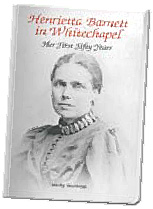 |
Henrietta Barnett in Whitechapel
Her First Fifty Years by Micky Watkins |
Back to Book Summary
Read Chapter 13 - Poor Law Children and Barrack Schools
A review by Chris Kellerman
Henrietta Barnett was born in 1851 to a wealthy south-London business family. She was their eighth child in 10 years, and her mother, who originally came from Germany, died shortly afterwards at the age of 32. Nowadays Henrietta is best remembered as the founder of Hampstead Garden Suburb, but by the time the first cottages were built she was 56 years old and had a successful career behind her. It is this period which is covered in Micky Watkins's new biography.
At 16 Henrietta was sent to a boarding school near Dover. Until then she had been educated at home. Through one of her teachers at school she became interested in social matters, and the two years after leaving school determined the future course of Henrietta'a life. Following the death of her father in 1869, Henrietta moved with two of her sisters to Bayswater. She began to do voluntary social work for her new church in Bryanston Square by visiting the poor in their homes. It was here that she first met Octavia Hill who was to have such a profound and enduring influence. There was a growing band of middle class women who felt that the condition of the poor in the capital was unacceptable, and believed that they had a moral duty to improve conditions by undertaking social work. Octavia introduced Henrietta to a variety of wealthy and influential people, and it was at one of these parties that she met her future husband, Canon Barnett. They were married in 1873. On the death of her father Henrietta had inherited close to £500,000 in today's money, and she was much better off than Samuel. However, under the Married Women's Property Act she was forced to put the money in trust once she married.
Although the Canon was offered a job near Oxford, they decided to take the Parish of St Jude's in Whitechapel so that they could live and work among the poor. They were surrounded by the worst slums and destitution of Victorian London. Within a year the young married couple had started a primary school, adult education classes, concerts, a lending library, flower show, and a support group for young mothers. Henrietta was particularly concerned about the plight of prostitutes, and it is estimated that there were around 2000 working in the Whitechapel area alone. One practical solution which Henrietta supported was to place girls at risk into domestic service.
Other initiatives started at this time included country walks, and she took people from Whitechapel to visit wealthy friends around London in horse-drawn vans. She helped form the Children's Country Holiday Fund so that children from poor families could have holidays in the country. Through Octavia Hill Henrietta was influenced by the teachings of Ruskin, in particular that it was not enough to improve the material wellbeing of the poor through better living conditions, but that their cultural and spiritual needs should also be addressed. Besides arranging concerts and country walks Henrietta borrowed contemporary pictures from artists, dealers and wealthy owners, and organised exhibitions. These were so successful that they eventually led to the creation of the Whitechapel Art Gallery, which opened in 1901. Unlike Octavia Hill, Henrietta believed that more radical and far-reaching solutions were required than simply helping the poor to find employment, and this involved living among the most disadvantaged.
Samuel, who was a graduate of Wadham College, encouraged Oxford graduates and students to live and work in the East End. This led to the founding of Toynbee Hall in 1884. Besides her social work she wrote numerous articles and books, and was sought after as a public speaker. By the 1890s she had become a well-known establishment figure.
During their round-the-world trip in 1890 the Barnetts met Gandhi and were entertained by the Viceroy of India. They stayed with the Rothschilds and met Balfour, Asquith, and members of the Royal Family.
Although aspects of Henrietta's life have been covered in various publications, this is the first systematic biography. Micky Watkins paints a vivid picture of the East End and the way in which Henrietta came to leave her personal mark with institutions such as Toynbee Hall and Whitechapel Art Gallery which continue to this day. It is a highly informative and well-written book, and puts the later development of the Suburb into context. Without Henrietta's drive and determination - and her connections among the Great and the Good of the time - it is difficult to see how the Suburb could have come into existence.
Another great strength of this book is that Henrietta's character shines through her many achievements, and by the end the reader has a real understanding of what she must have been like as a person.
Micky wears her scholarship lightly, and although she has consulted all the available sources the book is written in an entertaining and readable style. It includes over 25 photographs and illustrations, and at £9.00 is excellent value.
Chris Kellerman, October 2005